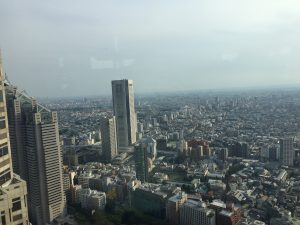Our day started at the beautiful Waseda campus. After meeting Aridome-Sensei’s old friend and our tour guide Ozaki-San, who is a beautiful, energetic lady, we took the busy morning train to our first stop, Tsukiji Market. To my surprise, Tsukiji was still very busy even after the crazy auctions (which we were not able to go today), and it was incredibly engaging and rich in culture.
To my surprise, Tsukiji was still very busy even after the crazy auctions (which we were not able to go today), and it was incredibly engaging and rich in culture. Observing the structure of the market reveals some interesting facts about Tsukiji. As it is distinctively divided into the intermediate wholesaler’s area and the outer normal market(I don’t know how to call it), the two parts target on different clients. The wholesaler’s area, as the name suggests, targets at the wholesalers and focuses on the early morning auctions. Whereas the normal market was flooded by tourists of all nationalities taking selfies while holding a giant piece of grilled squid or たまこ焼き. In the 通り outside of Tsukiji Market were a row of all kinds of small restaurants hosting all kinds of guests–middle school students, workers, サラリーマン in suits, and of course, some tourists. Although crowded and not neat, the diversity of the street created harmony in the smell of sea(food), car exhaust, and all kinds of foods.
 Shops inside the wholesaler’s area
Shops inside the wholesaler’s area
However, just as you think at Tsukiji you have all the choices in the world, you will soon realize the choices were already made for you. Although there are 200 tons of fish (I might be messed up with the number a little) sold every day at Tsukiji, the categories you can buy are limited. As we observed in the market, all the shops had almost identical 種類 for guests to pick, Tuna being the major fish. Lobsters and crabs and some other less common fish were less popular. All the shops had giant Tuna heads on the counters to scare off or impress clients and innocent tourists. Bringing up the different concepts of いちば and しじょう mentioned in the article “Wholesale Sushi Culture and Commodity in Tokyo’s Tsukiji Market”, Tsukiji is a place where the two concepts interact: the shijyō influences the economics of fish markets and determines the distribution of different kinds of seafood at the ichiba.
The opposite of Tsukiji Market, which strives on the lowest level of Tokyo’s architectures, the skyscrapers are the defining features of the height of Tokyo. Looking down from 46th floor in Dentsu Tower (電通タワー), it amazed me how the incredibly diverse architectures of Tokyo talk to each other. While the whole city was crammed with buildings of all heights, there were still parks and greens to let it breathe, as well as the multi-level futuristic design of some buildings that brings out fantasies of the city. Although so densely organized that all land is utilized, Tokyo allows an organic mixture of modernity and nature, as evident not only in the 偉い view from the top floor of 東京都庁舎 but also in Ueno Park where people and nature, as well as religions, interact.
Ueno Park was nothing more than a square of greens if looking from high up, but when actually wandering in the park, I found it a highly culturally engaging place. First, there is a temple and a shrine, allowing people to make wishes accordingly; in fact, the most fun part of our Ueno Kōen trip was reading all kinds of wishes and seeing other people’s 悩みや願望–perhaps we all have the desire to peek into other people’s private lives. Also, Ueno Kōen incorporates all kinds of people–small children, tourists, サラリーマン, and lovers. Surrounded by ambitiously tall “towers”, Ueno Kōen supports them like the roots deliver nutrients to their fruits. In this sense, the Shinto shrine and the Buddhism temple Ueno is providing a shelter for could be seen as the roots for the tall buildings of modernity.

